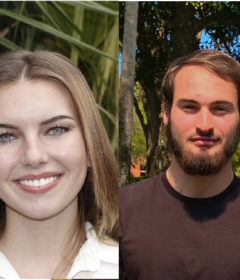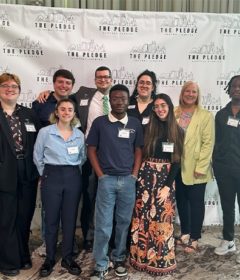Florida Formations: More for the Eye to Behold
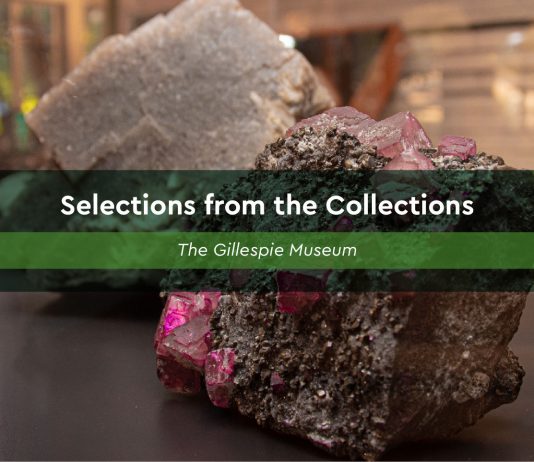
Founders T.B. and Nellie Gillespie thought of their home state as “scarcely mineralized.” Although eager to make their collection available to Floridians, the Gillespie’s were not especially interested in the state’s minerals. As a result, by far the majority of specimens in the Historic Gillespie Collection are from North American and international regions of greater brilliance.
Still, the 21 Florida specimens in the founding collection are especially fine ones. There are several rare and fragile calcite crystals, formed as pool deposits in Crystal Spring Quarry Number 2, Lecanto, Citrus County. There are remarkable geodes, agatized coral fossils, from the storied Ballast Point of Tampa Bay, where in the 1840s’ Florida mineral collecting begin. Early explorers and scientists published descriptions of the colorful fossils, formed in limestone and ancient soils and exposed on the shore. Today, such localities have been closed to the public or permanently changed by human development.
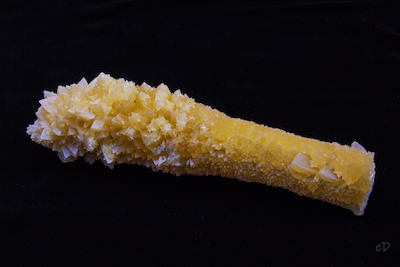
And more Florida specimens have steadily been collected at the museum.
Soon after Wendy Tanner joined the museum staff in 2016, she began to help in planning Florida Formations, a now-permanent exhibit telling 500 million years of geological history of the peninsula through its formations. (A formationis a rock unit with constituent minerals and fossilized biota setting it apart from surrounding rock layers.)
A native Floridian and a trained anthropologist and archaeologist at Florida State University (Master of Science) and the University of Tennessee (All But Dissertation), Tanner knew her way around the state’s digs. She led a team, which included Jon Bryant of Northwest Florida State College, Guy “Harley” Means of the Florida Geological Survey, Ben Tanner of Stetson’s Environmental Science and Studies Department, and John Sacha of the television series Fossil Hunters.
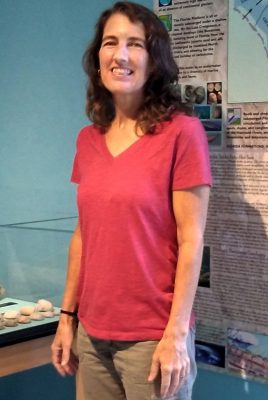
The challenges were threefold: how to dazzle with a group of rock formations and minerals that, at first glance, seem common and too similar (limestone, limestone, limestone); how to fit millions of years of geology into approximately 200 square feet of display space; and how to expand the museum’s collection to tell a deeper story.
Wall Panels, Wall Color and More Specimens
Researching and consulting tirelessly for six months, Tanner created a storyline that would fit the four display cases which could squeeze into the space, and designed colorful, fact-filled panels to tell complex stories of sea-level change, shifting sediments and emerging ecosystems. With her guiding hand, the museum acquired new fossils and representative specimens from local collectors, as well as from the Tanners’ personal collection and the Florida Geological Survey.
The Gillespie’s Florida Collection now has more than 200 specimens — with 140 of those in the Florida Formations exhibit or integrated into displays throughout the museum.
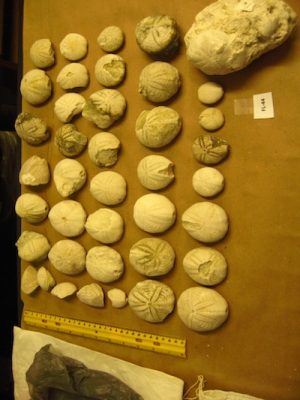
Visitors now can notice the differences in shade between the striations in a dolomite specimen from the Avon Park Formation (Eocene, 56 to 34 million years ago), showing organic layers of seagrass remains that indicate development in a shallow marine environment; and the deeper hues of dolostone formed in Suwanee Limestone (Oligocene, 32 to 26 mya) with embedded Echinoid fossils. Those specimens contrast with the dark gray shades of a rhino tooth, showing the organic-rich compounds of the substrate after the peninsula emerged from the sea about 20 million years ago, allowing for the plant life to support large terrestrial mammals.
Among many other finds, the careful observer may notice a large palm-frond fossil (Sabalites apalachicolaensis) or sediment layers of oxidized Saharan dust in the Fort Thompson Formation from approximately two million years ago. (A Fossil Scavenger Hunt here introduces 14 plant and animal species from Florida’s past.)
The exhibit and connections made during its development have led to two additional major exhibits on Florida Calcite and Agatized. Also, they have created opportunities for Science Café lectures and programming by geologists from the Florida Geological Survey and elsewhere in the state. Most importantly, the expanded Florida Collection has meant that in addition to world treasures, students to the museum can know the rocks and minerals under their feet.


